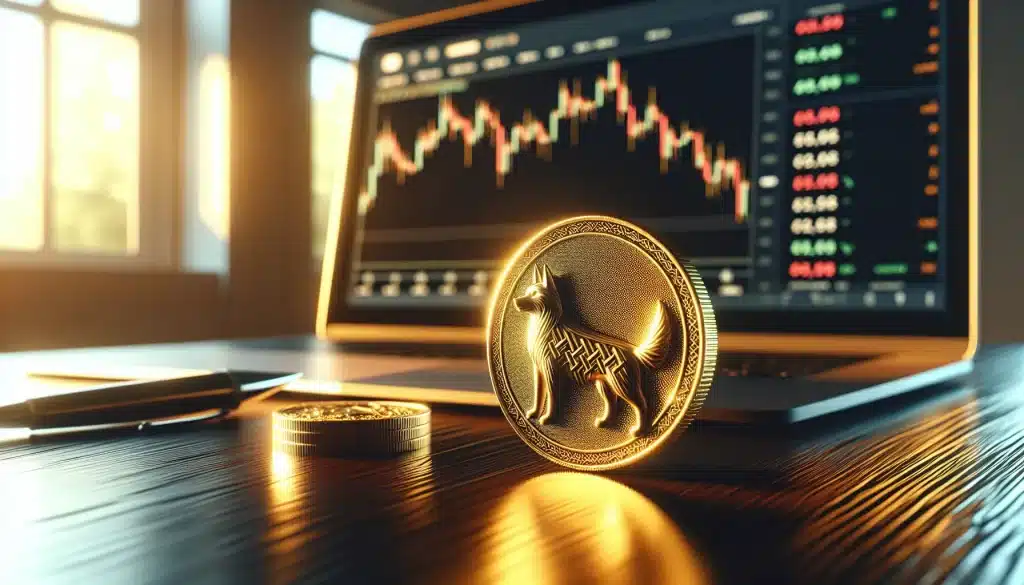You’ve probably heard the whispers across crypto forums and social media, “Can Floki Inu hit $1?” It’s a question that ignites excitement among holders and skepticism among seasoned analysts. Named after Elon Musk’s Shiba Inu dog, Floki Inu burst onto the meme coin scene with ambitious marketing and a passionate community. But let’s be honest: reaching a dollar price point isn’t just about enthusiasm and viral tweets. It requires understanding market mechanics, tokenomics, and some hard mathematical truths that many investors prefer to ignore. Before you invest another dollar or dismiss the possibility entirely, you need to see what the numbers actually say. This isn’t about crushing dreams or hyping unrealistic outcomes, it’s about giving you a clear-eyed assessment of where Floki Inu stands and what would need to happen for that $1 target to become anything more than wishful thinking.
Key Takeaways
- The Floki Inu $1 possibility faces nearly insurmountable mathematical challenges due to its trillion-token supply, which would require a $9-10 trillion market cap—exceeding Apple, Microsoft, and Google combined.
- Even with aggressive token burning reducing supply by 99%, Floki Inu reaching $1 would still demand a $1 trillion valuation, larger than Bitcoin’s current market cap.
- More realistic price targets for Floki Inu range from $0.0001 to $0.001 in the short term during bull markets, representing significant gains without requiring impossible market caps.
- Floki’s ecosystem developments including Valhalla metaverse and FlokiFi products could drive price appreciation, but meaningful adoption beyond speculative interest remains critical for sustained growth.
- Investors should approach the Floki Inu $1 possibility as a community rallying cry rather than a serious prediction, focusing instead on realistic 10x-50x potential while only risking capital they can afford to lose.
- Token burning mechanisms and supply reduction offer the only viable mathematical path toward higher prices, but require years of sustained effort and verifiable on-chain implementation.
Understanding Floki Inu’s Current Market Position

Before you can evaluate Floki Inu’s potential to reach $1, you need to understand where it stands today. The cryptocurrency market moves fast, but context matters when you’re trying to separate realistic projections from fantasy.
Price History and Market Cap Analysis
Floki Inu launched in 2021 during the meme coin frenzy that followed Dogecoin and Shiba Inu’s explosive runs. Since then, the token has experienced the typical rollercoaster ride that defines most meme coins, sharp spikes followed by extended consolidation periods. At its peak during the 2021 bull market, Floki traded at prices that made early adopters substantial profits. But like most cryptocurrencies, it faced severe corrections during the 2022 bear market.
As of late 2024 and early 2025, Floki Inu trades at a fraction of a cent, typically in the range of $0.00001 to $0.0001, depending on market conditions. Its market capitalization fluctuates between hundreds of millions to over a billion dollars during favorable conditions. That might sound impressive until you realize what reaching $1 would actually require.
The project has made efforts to distinguish itself from pure meme coins by developing actual utility. From NFT marketplaces to planned metaverse projects, Floki’s team has tried building an ecosystem rather than relying solely on social media hype. But these developments, while noteworthy, haven’t fundamentally altered the token’s price trajectory in ways that suggest a $1 valuation is anywhere on the horizon.
Token Supply and Circulating Economics
Here’s where things get real. Floki Inu launched with an initial supply of 10 trillion tokens. Yes, you read that correctly, trillion with a T. Even after various token burns that the team has implemented, the circulating supply remains in the trillions.
This massive supply is both a feature and a constraint. On one hand, it allows millions of people to hold billions of tokens, creating a sense of ownership and community engagement. Psychologically, owning a billion of something feels more exciting than owning 0.0001 of something, even if the dollar value is identical.
On the other hand, basic economics tells you that price equals market cap divided by circulating supply. With trillions of tokens in circulation, even modest price increases require enormous injections of capital. You’re not dealing with Bitcoin’s 21 million supply cap or Ethereum’s more manageable numbers. The sheer volume of Floki tokens creates mathematical constraints that no amount of community enthusiasm can overcome without fundamental changes to the tokenomics.
The Mathematical Reality Behind a $1 Price Target
Let’s do the math that many investors skip when they’re caught up in the excitement. Numbers don’t lie, and they don’t care about your hopes or how strong the community feels.
Market Capitalization Requirements
If Floki Inu were to reach $1 per token with its current supply of roughly 9-10 trillion tokens (accounting for burns), the market capitalization would be $9-10 trillion. Stop and think about that for a moment.
That market cap would make Floki Inu worth more than Apple, Microsoft, and Google combined. It would represent a significant portion of the entire global stock market. In cryptocurrency terms, it would be multiple times larger than Bitcoin’s market cap, which has taken over a decade to build and represents the most established and trusted digital asset in existence.
Even if you assume aggressive burning mechanisms reduce the supply by 90%, leaving 1 trillion tokens, a $1 price would still require a $1 trillion market cap. That would make Floki larger than Bitcoin is today and roughly equivalent to the entire market cap of silver as a precious metal.
These aren’t just big numbers. They represent a level of capital inflow that has no precedent in cryptocurrency history for a meme-based token. You’d need institutional adoption on a scale that even Bitcoin and Ethereum are still working to achieve.
Comparison to Global Financial Markets
To put this in perspective, the entire cryptocurrency market at its peak in 2021 reached about $3 trillion. For Floki alone to hit the market cap needed for a $1 price, it would need to capture multiples of the entire crypto market’s historical high.
Compare this to traditional markets: the global stock market is valued at roughly $100 trillion, global real estate around $280 trillion, and all the gold ever mined approximately $12 trillion. A $10 trillion Floki would rank among the most valuable asset classes in human history.
You might be thinking, “But couldn’t crypto grow large enough to support these valuations?” Sure, theoretically. If cryptocurrency becomes the dominant form of global value storage and transactions, the total market could expand dramatically. But even in that scenario, would a meme coin with limited fundamental utility capture that value? Or would it flow to assets with deeper infrastructure, institutional backing, and established use cases?
The comparison isn’t meant to crush your optimism entirely, it’s meant to give you a realistic framework. Markets can surprise us, but they still operate within the bounds of capital availability and investor psychology.
Factors That Could Drive Floki Inu’s Price Higher
Even though the mathematical challenges, several factors could push Floki’s price upward. Understanding these gives you a clearer picture of what would need to happen for significant price appreciation, even if not to $1.
Token Burning Mechanisms and Supply Reduction
Floki Inu has implemented periodic token burns, permanently removing tokens from circulation. This deflationary mechanism is one of the few viable paths toward making higher prices mathematically possible.
If the team and community committed to burning 99% of the supply, reducing it from trillions to tens of billions, the math starts looking less impossible. With 50 billion tokens in circulation, a $1 price would “only” require a $50 billion market cap. That’s still massive and would place Floki among the top cryptocurrencies, but it’s at least within the realm of what large-cap cryptos have achieved.
The challenge is that aggressive burning requires either the team to have control over massive token reserves, or a mechanism that burns tokens through transactions. Transaction-based burning only works if volume is substantial and sustained, which creates a chicken-and-egg problem: you need high prices to generate volume, but you need volume to reduce supply and enable high prices.
Ecosystem Development and Utility Expansion
Floki has differentiated itself by attempting to build real utility. The project has launched Valhalla, a play-to-earn metaverse game, and FlokiFi, a set of decentralized finance products. There’s also been discussion of merchandise, NFTs, and partnerships with various platforms.
If these ecosystem components gain genuine adoption, not just speculative interest but actual daily users who need FLOKI tokens to participate, the demand side of the equation improves. Think about how Ethereum’s price is supported by its utility as the foundation for thousands of applications. If Floki could create even a fraction of that utility value, it would strengthen the case for higher valuations.
The problem is that most meme coins that promise utility never achieve meaningful adoption. The crypto landscape is littered with projects that had roadmaps and whitepapers but never translated those plans into sustained user engagement. You need to watch for actual metrics: active users, transaction volumes, revenue generation from ecosystem products.
Market Sentiment and Community Growth
Never discount the power of community and sentiment in crypto markets. Dogecoin reached an $80 billion market cap largely on the strength of social media enthusiasm and high-profile endorsements. Shiba Inu achieved similar peaks.
Floki’s community, known as “Floki Vikings,” is active and dedicated. They’ve funded billboard campaigns in major cities, sponsored sports teams, and maintain constant social media presence. If this community can grow significantly and attract whale investors or celebrity endorsements (particularly from Elon Musk, whose dog inspired the token), sentiment-driven rallies become possible.
But here’s what you need to understand: sentiment-driven prices are typically temporary unless backed by fundamental value. Dogecoin’s price crashed from its peaks, and most holders who bought near the top experienced significant losses. Sentiment can drive 10x or even 100x gains, but sustaining those gains requires more than enthusiasm.
Challenges and Obstacles to Reaching $1
Being realistic about obstacles isn’t pessimism, it’s the foundation for making informed decisions. Several structural challenges make the $1 target extraordinarily difficult.
Massive Supply Constraints
We’ve touched on this, but it deserves emphasis: the supply problem isn’t just a hurdle, it’s a near-insurmountable wall. Even with aggressive burning, reducing supply by 99% or more would take years and require mechanisms that might not be technically or economically feasible.
Many tokens have burning mechanisms written into their smart contracts, but the rate of burn often doesn’t keep pace with the emission or circulation rates. If Floki burns 1% of supply annually while the market expects 10x price growth, the math still doesn’t work.
There’s also the question of who controls the tokens to be burned. If they’re held by the team or foundation, burning them is essentially the team diluting their own holdings for the benefit of other holders. That’s admirable but creates governance and incentive issues. If the tokens to be burned need to come from circulation through transaction fees, you’re dependent on sustained high volume, which as mentioned earlier, creates circular dependency problems.
Competition in the Meme Coin Space
Floki isn’t competing in a vacuum. The meme coin space is crowded with dozens of projects all vying for the same pool of speculative capital. Dogecoin has first-mover advantage and mainstream recognition. Shiba Inu has a larger community and its own ecosystem developments. Newer entrants emerge constantly, often with more aggressive marketing or novelty factors.
This competition fragments attention and capital. When a new meme coin launches with viral marketing, capital flows out of existing positions to chase the new opportunity. You’ve probably seen this pattern: a new dog-themed or celebrity-endorsed token launches, Floki’s price dips as traders rotate into the new hype, then both tokens eventually decline as the cycle moves on.
For Floki to reach extraordinary valuations, it would need to not just compete but dominate this space in a way that no meme coin has sustained long-term. That’s a tall order when the next viral token is always just around the corner.
More Realistic Price Predictions for Floki Inu
Let’s bring this back to earth. What are realistic price targets that don’t require suspending economic laws?
Short-Term and Long-Term Scenarios
In the short term, meaning the next 1-2 years, Floki could realistically target prices in the $0.0001 to $0.001 range during bull market conditions. This would represent significant gains from current levels (potentially 10x to 100x depending on entry point) without requiring impossible market caps.
At $0.0001 with current supply, Floki would have a market cap around $900 million to $1 billion, competitive with many established altcoins but not absurd. At $0.001, you’re looking at roughly $9-10 billion, which would place it among the top 20-30 cryptocurrencies. That’s ambitious but has precedent during previous bull cycles when speculative fervor drove similar projects to comparable valuations.
Long-term scenarios depend heavily on execution. If Floki successfully builds its ecosystem, achieves meaningful utility, and implements aggressive supply reduction, a price of $0.01 might be possible over a 5-10 year horizon. This would require a combination of market growth, supply burns reducing the token count to hundreds of billions rather than trillions, and sustained adoption of the platform’s products.
But $0.01 is still 100x away from $1. Getting from $0.01 to $1 would require another 100x move on top of already extraordinary growth. The mathematical and market structure challenges make this exceptionally unlikely unless the entire premise of cryptocurrency changes dramatically.
What Investors Should Consider
If you’re thinking about investing in Floki Inu, base your decisions on realistic expectations rather than $1 dreams. A 10x or even 50x return from current levels would be life-changing for many investors and is at least within the realm of possibility given crypto’s volatility and meme coin history.
Consider your risk tolerance carefully. Meme coins are among the highest-risk assets in an already high-risk asset class. You should only invest money you can afford to lose completely. The same volatility that can generate 100x gains can also result in 90% losses, often within weeks.
Watch for concrete developments rather than hype. Token burn announcements with verifiable on-chain data matter more than social media campaigns. Actual user numbers for Valhalla or FlokiFi products matter more than partnership announcements. Revenue generation from ecosystem projects matters more than roadmap promises.
Diversification is your friend. If you believe in Floki’s potential, it can be part of your crypto portfolio, but it shouldn’t be the entirety. Balance speculative positions with more established assets that have proven track records and fundamental value propositions.
Conclusion
Can Floki Inu reach $1? The honest answer, based on current tokenomics and market realities, is almost certainly no, at least not without changes so fundamental that the token would be unrecognizable from its current form. The market cap requirements are simply too extreme given the token supply, even accounting for aggressive burning mechanisms.
But that doesn’t mean Floki is without potential. Significant price appreciation is possible, especially during crypto bull markets when speculative capital flows freely. Returns of 10x, 20x, or even higher aren’t out of the question if conditions align, strong overall crypto market, successful ecosystem development, effective marketing, and continued community growth.
Your job as an investor is to separate fantasy from possibility. The $1 target functions more as marketing and community rallying cry than as a serious price prediction. What matters is whether Floki can achieve growth that makes financial sense for your situation and risk tolerance.
Approach Floki and similar meme coins with clear eyes. Understand the math, watch for genuine developments over hype, never invest more than you can lose, and maintain realistic expectations. The crypto market has created extraordinary wealth for some and devastating losses for others. The difference often comes down to who understood the actual odds versus who got caught up in the dream.
You’ve got the information now. What you do with it is up to you.
Frequently Asked Questions
Can Floki Inu realistically reach $1 per token?
Based on current tokenomics, it’s highly unlikely. With trillions of tokens in circulation, a $1 price would require a $9-10 trillion market cap, exceeding Bitcoin and rivaling the world’s largest companies combined. Even aggressive token burns make this mathematically improbable.
What is a realistic price target for Floki Inu in the next 1-2 years?
Short-term realistic targets range from $0.0001 to $0.001 during favorable bull market conditions. This would represent significant gains without requiring impossible market capitalizations, placing Floki among competitive mid-tier cryptocurrencies.
How do token burns affect Floki Inu’s price potential?
Token burns permanently reduce circulating supply, making higher prices mathematically more achievable. If Floki burned 99% of its supply, a $1 price would require a $50-100 billion market cap instead of trillions—still massive but theoretically possible.
What makes Floki Inu different from other meme coins?
Floki attempts to build actual utility through its Valhalla metaverse game, FlokiFi DeFi products, and NFT marketplace. Unlike pure meme coins, it’s developing an ecosystem, though meaningful adoption beyond speculation remains the key challenge for long-term value.
Is Floki Inu a good investment for beginners?
Meme coins like Floki are extremely high-risk, even within cryptocurrency. Beginners should only invest money they can afford to lose completely, maintain realistic expectations, diversify their portfolio, and prioritize learning about established cryptocurrencies with proven fundamentals first.
What market cap would Floki Inu need to reach $0.01?
With current supply levels around 9-10 trillion tokens, Floki would need approximately a $90-100 billion market cap to reach $0.01. This would place it among the top cryptocurrencies and require substantial ecosystem development, adoption, and favorable market conditions over 5-10 years.






